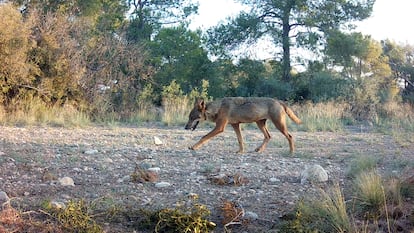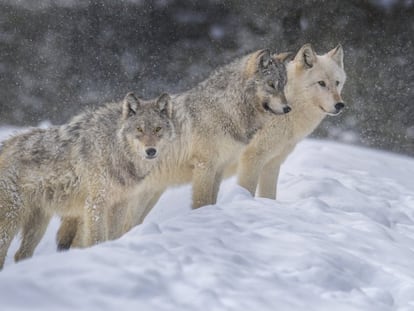The only known Iberian and Italian wolf couple lives in northeastern Spain
Decades ago, Italian canids crossed the Pyrenees into Aragón where their Iberian cousins live

The male wolf is from Italy (Canis lupus italicus), while the female is from Spain (Canis lupus signatus). The only known case of an Iberian and Italian wolf couple lives in Aragón (between Alcañiz, Hijar and Caspe), a landlocked region in northeastern Spain. Over the years, Italian canids migrated to France and established a stable population. Recently, they started traveling to Spain across the Pyrenees mountain range. The confirmed pairing of individuals from both populations is considered great news, as it could potentially enrich the species through successful reproduction.
“The pair has been together for some time now, so it’s possible that they will breed next season,” said Manuel Alcántara de la Fuente, who heads Aragón’s biodiversity unit. The mating season of the species starts at the end of winter, and births happen in spring. Alcántara says it’s “unlikely” that they already reproduced this year and that the cubs have gone unnoticed. Photos and videos show a very thin female with no visible breast development.
Wolves made a comeback in Aragon during the early 2000s. In 2017, a male wolf of transalpine origin settled in Aragón’s sparsely populated Los Monegros region. Through genetic analysis, the Aragón government later confirmed the presence of five canids in that region — four wolves of Italian origin and one Iberian wolf. In April, one of the males from Los Monegros who was often seen with a female, was hit by a vehicle and died in Alcañiz. Another wolf briefly passed through the area, while one frequently moves in and out of the community. Currently, the only two wolves permanently living in Aragón are the Iberian-Italian couple. Wolves are monogamous and tend to stay together.
“It is indeed great news, but successful reproduction would be even better as it would enhance the genetic diversity of the Iberian wolf population. We are on the verge of a significant breakthrough,” said the World Wide Fund for Nature (WWF) local conservation coordinator, Luis Suárez. The Italian canids arrived in the Pyrenees 30 years ago after leaving the Apennine Mountains (Italy), and crossing the Alps, highways and other obstacles. By 1992, they had settled in France and then made their way to Spain. “They haven’t reproduced because almost all the specimens are males. Females also move into new areas, but the male wolves tend to travel longer distances,” said biologist Juan Carlos Blanco, an expert in carnivores. “These are dispersing specimens. I would classify them as Franco-Italian, as they were most likely born in France, even though they originate from Italy.”
Blanco doesn’t believe crossbreeding among the two populations will cause any problems. “Controversy could arise if humans had brought them together, but the fact of the matter is that they arrived on their own. This decision by the species will result in greater genetic diversity and contribute to the regeneration of the European wolf.” Blanco doesn’t place much importance on arguments about subspecies distinctions because 300 years ago, wolves from southern Spain to Norway exhibited minimal differentiation. While isolated populations have developed some differences, these variations are not considered significant from an adaptive standpoint. “They all come from one main line,” said Blanco.
The two populations are very similar, making it challenging to distinguish the origin of a specimen by simply looking at it. “They have nuances that are almost impossible to detect,” said Alcántara. However, he does see differences in their propensity for travel. “It seems that wolves from the transalpine region disperse more. They have traveled across Europe and passed through places as developed as the Gulf of Marseille. However, wolves from around here don’t move around much.” According to Luis Suárez from WWF, the issue stems from the previous approach to species control before protections were implemented. “The expansion of Iberian wolves was curtailed by overhunting. The specimens never went beyond La Rioja [northern Spain] and never made it to the Pyrenees. How did we let this happen?”
If the pair in Aragón produce offspring, they could establish links to the Iberian wolf population in Guadalajara (central Spain) and expand the territorial reach of the species. “Currently, they are separated by half of Guadalajara province and nearly all of Teruel province,” said Blanco.
The growing wolf population in Europe is causing concern, leading the European Union to consider reducing current protections. “The presence of wolves always worries people, but they haven’t caused much harm. We maintain constant communication with the ranchers,” said Alcántara. Financial aid is also available to protect livestock herds with fences and dogs. “When a wolf was spotted in Los Monegros, everyone thought the sky was falling. But it turned out not to be such a big deal.” In the area where the Iberian-Italian wolf couple has settled, they have access to an abundant source of wild game to feed on, such as rabbits, roe deer and wild boar.
Sign up for our weekly newsletter to get more English-language news coverage from EL PAÍS USA Edition
Tu suscripción se está usando en otro dispositivo
¿Quieres añadir otro usuario a tu suscripción?
Si continúas leyendo en este dispositivo, no se podrá leer en el otro.
FlechaTu suscripción se está usando en otro dispositivo y solo puedes acceder a EL PAÍS desde un dispositivo a la vez.
Si quieres compartir tu cuenta, cambia tu suscripción a la modalidad Premium, así podrás añadir otro usuario. Cada uno accederá con su propia cuenta de email, lo que os permitirá personalizar vuestra experiencia en EL PAÍS.
¿Tienes una suscripción de empresa? Accede aquí para contratar más cuentas.
En el caso de no saber quién está usando tu cuenta, te recomendamos cambiar tu contraseña aquí.
Si decides continuar compartiendo tu cuenta, este mensaje se mostrará en tu dispositivo y en el de la otra persona que está usando tu cuenta de forma indefinida, afectando a tu experiencia de lectura. Puedes consultar aquí los términos y condiciones de la suscripción digital.
More information
Archived In
Últimas noticias
A survivor’s account of the Interoceanic Train accident: ‘We were scared because of the speed on the curve’
The Interoceanic Train, the Mexican alternative to the Panama Canal
What is known about the Interoceanic Train derailment in Oaxaca
Trump turns a Minnesota fraud allegation into ammunition for his MAGA army against Democrats
Most viewed
- Oona Chaplin: ‘I told James Cameron that I was living in a treehouse and starting a permaculture project with a friend’
- Reinhard Genzel, Nobel laureate in physics: ‘One-minute videos will never give you the truth’
- Why the price of coffee has skyrocketed: from Brazilian plantations to specialty coffee houses
- Pablo Escobar’s hippos: A serious environmental problem, 40 years on
- Chevy Chase, the beloved comedian who was a monster off camera: ‘Not everyone hated him, just the people who’ve worked with him’











































